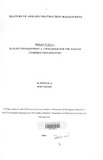| dc.description.abstract | Increasing degree of competition on several fronts of business aspects has caused the
management of organisations to think of ways of increasing their competitiveness in the market
place. Of these adjustment techniques that have been applied in coping with these developments,
the concept of quality has been used in the management of organizations with a view to
maintaining customers on a long-term basis. Organisations have therefore turned their attention to
managing for quality. Managing for quality has required the organisations to rely on the basic
tenets and philosophy of Quality Management that have been postulated in the discipline of Total
Quality management.
Total Quality Management techniques have been used extensively and beneficially in the areas of
Manufacturing and Industrial engineering processes to control processes and prevent defects
before they occur, ultimately saving millions of shillings. The purpose of this research paper is to
find out how far concepts of Quality Management are applied in the Construction Industry in
Kenya. The objective is to find out the extent of awareness of participants in the Construction
Industry of Quality Management techniques. The study examines how the principles of customer
satisfaction, defects prevention and continuous improvement are practised if at all in the
Construction Industry in Kenya.
The literature reviews the term Quality and the development of Total Quality Management. It
also covers some typical concepts of Total Quality Management as proposed by various schools
of thought: Juran, Deming, and Crosby, which are later, used to develop the Theoretical
Framework. The literature focuses as well, on how these theories apply in the Construction
context
The findings of the study from five typical case studies are that Quality Management concepts are
not known let alone practised. The most used forms of Quality Control are supervisions and
inspections.
The research concludes that Quality Management on sites does exist but in the very traditional
form, Few people understand the concept of Quality Management as applied in Manufacturing
and many believe Quality is unattainable without inspections and supervisions. The conclusion is
that the human factor plays a significant role in achieving quality.
The recommends the starting point to achieving quality as the human element i.e. workers,
supervisors, designers and even clients themselves. There is need of ingraining into people the
fact that it is possible to do work right the first time even without supervision.
With that recommendation, the study ends with possible further areas of further research. | en_US |

